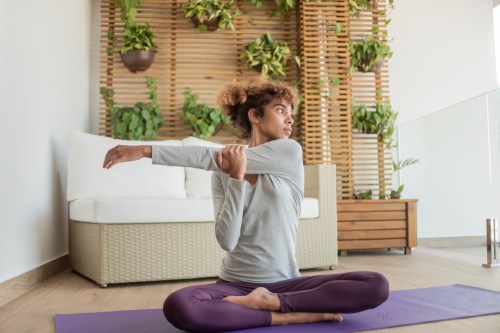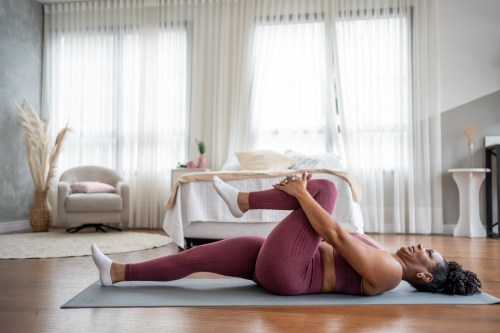Our editors independently select these products. Making a purchase through our links may earn Well+Good a commission
8 Shoulder Blade Stretches That Release Tension in the Tightest Part of Your Body
Shoulder blade stretches are incredibly soothing. Here, physical therapists share their favorite stretches for shoulder pain relief.

Your lower back is a hotspot for tightness and pain, but according to physical therapists, your shoulders tend to be even tighter.
Experts in This Article
physical therapist and co-founder of Body Evolved, a stretching and physical therapy studio in New York City
musculoskeletal expert and co-founder of Delos Therapy
certified personal trainer and director of training and experience at StretchLab
creator of the BURN Method
“Pain between the shoulder blades is by far the most common condition that we treat,” says Eric Owens, a musculoskeletal expert and co-founder of Delos Therapy.
According to Owens, this stiffness is primarily the result of sitting all day long, but there are remedies and shoulder blade stretches you can do for relief.
But first: What causes shoulder blade stiffness?
“We are a society that sits all of the time—on our way to work, all day at work, when we come home, when we go to bed,” says Owens. “Repeatedly being hunched over a phone or a computer… causes your muscle tissues to stiffen over time. So it’s a slow and steady accumulation of tightness inside of the muscle.”
With your shoulder blade area specifically, the hunching leads to this tightness, as does working out, running, poor posture, or your sleeping position, he says.
“Pain between the shoulder blades is by far the most common condition that we treat.” —Eric Owens, musculoskeletal expert
Why is shoulder blade mobility important?
Within your shoulder blade area are a number of muscles, all of which need to have proper function and good mobility in order for fluid upper-body movement.
“That includes your neck and shoulder joint health,” says Corinne Croce, DPT, physical therapist and co-founder of Body Evolved. “The shoulder blades play a critical role in the health of your rotator cuffs, which consist of four muscles that originate on the blade and insert via a common tendon in the glenohumeral joint.”
She stresses that your rotator cuff is essentially a second core, because its function is “necessary for adequate stability and upper body movement.”
Aside from supporting your upper body when it moves, your shoulder blade area is a connecting point for many other muscles throughout your body.
“This area allows for overhead range of motion, stabilization of the upper back and shoulders, and we’re constantly relying on this area of our body every day to aid in proper movement,” says Kelsey Decker, CPT, personal trainer and director of training and experience at StretchLab.
To stretch the shoulder blade muscles out, Owens recommends doing more than foam rolling, static stretching, and booking a massage (because he explains, that while these work alongside your muscles, tightness is typically deeper).
That’s not to say shoulder blade stretches aren’t beneficial, though. Certain stretches combined with targeted pressure can really help. To prove it, ahead you’ll find eight upper back stretches and scapula exercises that address deep knots in shoulder blades and help to offer instant relief.
Improve shoulder mobility with these shoulder blade stretches and techniques
1. Thera Cane pressure
To provide targeted pressure that can help break up tightness within the shoulder blade area, Owens recommends using a self-massage tool like the Thera Cane ($34), which you can get on Amazon. (For a higher-end self-massage tool, consider the Therabody Theragun Relief, $149)
“Any area that you’re noticing a dull ache when hunched over, hit it and apply direct pressure into it with something like a Thera Cane,” he says.
Hook the shorter arch on your back in the shoulder blade area, and find the spots that are really tight.
“Get right next to the vertebrae and down the center, but never touch the vertebrae itself or the spine,” he says, noting to work your way out laterally towards the scapula.
Try to draw a box at the top of the scapula and zigzag back and forth, giving two to three seconds of pressure in each spot before moving to the next. Avoid dynamic pressure, since this “can damage the tissue and make you feel worse,” Owens says.
Repeat the same technique on your trapezius muscles too. With each area, work both sides so that you have balance within your body.
2. Lacrosse ball as a wall massage
Another easy at-home stretch involves a small ball (Owens recommends a lacrosse ball, $7, which you can get from Amazon). Stand with your back against the wall with the ball on the spot that’s tight, then hold the corresponding arm across your chest.
“Lacrosse balls are wonderful to stretch everything in your scapula area out and really dig in,” he says.
Avoid rolling up and down; instead, as with the Thera Cane, hold pressure in one spot for two to three seconds, then move to a different point.
3. Doorway stretch
The doorway stretch is one of the most popular upper back stretches for shoulder pain relief. It improves flexibility, stretches your chest muscles, and relieves tension in your shoulder blades.
To perform the stretch, Mandy DiMarzo, creator of the BURN Method, says to stand in a doorway, raise your arms to shoulder level, and place your hands on the door frame by bending at the elbows. “Gently lean forward, feeling the stretch across your chest and shoulder blades,” she instructs.
For optimal muscle tension release, DiMarzo says to perform this shoulder blade stretch daily, especially if you spend extended periods at a desk. “It helps counteract forward-slouching posture,” she says.
4. Parallel-arm shoulder stretch
Decker and DiMarzo recommend this move that stretches and strengthens your upper back and shoulder muscles to reduce stiffness and enhance mobility.
You begin by standing upright with one arm across your body. Keep your arm parallel to the ground and pull your elbow towards your opposite shoulder.
For best results, DiMarzo says to perform this scapula exercise two to three times per day, “especially after long periods of sitting or working on a computer,” she emphasizes. It targets and strengthens the upper back and shoulder muscles, promoting flexibility and reducing stiffness, she adds.
5. Bent-arm shoulder stretch
This is a variation of the parallel arm shoulder stretch that targets and relieves your upper back and shoulder muscles.
To perform it, stand upright with one arm across your body. Bend your arm at 90 degrees and pull your elbow toward your opposite shoulder.
6. Crossover shoulder stretch
Address deep knots in your shoulder blades with this easy-to-execute upper back stretch that targets your upper back and shoulders to offer muscle tension relief.
Stand with your knees bent; cross your arms over and grab the back of your knees. Keep hold of the back of your knees and start to rise upwards until you feel tension in your upper back and shoulders.
If standing feels unsteady, you can also perform this exercise seated. Just cross your arms in front of you, grab your knees, and wiggle your upper back until you feel that oh-so-good scapula stretch.
7. Reaching up shoulder stretch
Growing up, you likely had to perform scapula exercises in gym class, in which you placed one arm above your head and one extended down, bending both at the elbow to grasp your hands behind you. This move promotes internal and external shoulder rotation, enhancing mobility overall.
Over the years, you may have lost the ability to do so. That’s a sign of lessened mobility—but it’s not something you can’t work to regain.
To do so, place one hand behind your back and reach up between your shoulder blades. As it becomes easier, consider adding a strap to the mix. Sling it over your shoulder, grab it with your lower hand, and gently pull it upward with your upper hand.
As this becomes easier, you’ll eventually be able to reach your hands together once more. The key to reaching that point is to hold each stretch for at least 10 seconds and ideally up to 30.
8. Child’s pose
At the end of any yoga practice or class, as well as at any point during it when you simply need a breather, child’s pose is encouraged. This move lengthens your spine and relaxes your back and shoulder muscles.
“It relaxes and stretches the entire back, including the shoulder blades,” DiMarzo says.
To perform the tension release exercise, she says to “kneel on the floor, sit back on your heels, and extend your arms forward. Lower your chest towards the floor, feeling a stretch across your shoulders and upper back.”
For optimal relief, DiMarzo says to perform child’s pose regularly as part of a broader stretching routine, as well as after any intense workouts. “It encourages spine alignment and reduces tension in the shoulder region,” she says.
How to treat and prevent shoulder blade pain
If your shoulder blade pain is not being relieved from these stretches, Owens says that cold therapy1—not heat—can help. “Heat does nothing to loosen up tightness within your muscle tissue,” he says. “If the area becomes inflamed, ice can help with some of the inflammation.” That said, he notes that an ice pack is only going to give you temporary relief.
To make sure you’re not stressing out over shoulder blade pain in the future, the first thing to do is undo the damage. “We have to remove the accumulation of tightness that occurs in your tissue over years,” says Owens.
“Once we remove it, periodic pressure into the tissue will help to keep it pliable.” That means making sure to hit up your Thera Cane or lacrosse ball regularly to undo knots and tension that build up over the course of a week of sitting at a desk.
Much like you treat your dental health, Owens says that your muscles should be addressed with a regular regimen. “The model that we use to prevent stiffness is nonexistent. Then, when people hit, say, 40-years-old, they get stiff,” he says. “Before that accumulation of tightness really sets in, we should be applying pressure periodically into the tissue to keep it loose and healthy.”
He says this can be done through a once-a-year appointment with a massage therapist or physical therapist (kind of like a teeth cleaning). “What we’re hoping is that it will become common knowledge that we need to be doing something regularly to have healthy muscle tissues.”
Then, commit to a daily or weekly (depending on your level of muscle tightness) stretching routine. “You can do the proper shoulder blade stretches for five to 10 minutes daily, or weekly, once you feel better,” says Owens. When you’re at work, he says that moving around during the day can help, too.
“Change positions when you’re at work. If you’re working for eight hours, try a standing desk and walking around,” he says. “It’s important to not stay in one position for too long.”
According to Croce, stretching and massage therapy aren’t all you should be doing for your shoulder blade health—you should prioritize mobility work, too.
“You want to keep these muscles mobile by keeping the tissues surrounding the shoulder blade moving, maintaining proper shoulder joint range of motion, and working on appropriate rhythmic control through the full range of shoulder blade motion,” she says.
A great tool for this is a resistance band, which you can use for various exercises that open up the shoulder area and all of the muscles surrounding it (plus, it’s low impact).
Try the at-home resistance band back workout below, courtesy of trainer Bec Donlan, to work all of your shoulder blade and postural muscles:
A word to the wise
Even with a diligent stretching routine, there is a difference between discomfort—that the above techniques can help alleviate—and real pain.
“Usually when there is pain, such as a sharp pinch, in the shoulder blade during movement and it is restricting one’s mobility or range of motion, this would be an optimal time to seek professional help such as a doctor or physical therapist,” Decker says. “When there is discomfort with movement and limited range of motion, seeking relief from a stretching professional would be a good route of treatment.”
FAQ
1. What are the best stretches for shoulder blade pain?
The doorway stretch, crossover shoulder stretch, bent-arm shoulder stretch, and child’s pose are a few of the best shoulder blade stretches. Learn how to do them—and more!—above.
2. How often should I perform shoulder blade stretches?
A good starting point is three to seven times per week, according to Harvard Health Publishing. However, everyone is different, so do what feels good for you. You may want to chat with a physical therapist or other healthcare professional to nail down a specific stretching program that works best for you.
3. Can shoulder blade stretches help improve posture?
One way to better your posture is to stretch and strengthen your muscles, according to the Hospital for Special Surgery. This includes stretching your shoulders. Other important muscles to stretch and strengthen include your core, chest, and upper back, per Harvard Health Publishing.
Singh DP, Barani Lonbani Z, Woodruff MA, Parker TJ, Steck R, Peake JM. Effects of Topical Icing on Inflammation, Angiogenesis, Revascularization, and Myofiber Regeneration in Skeletal Muscle Following Contusion Injury. Front Physiol. 2017 Mar 7;8:93. doi: 10.3389/fphys.2017.00093. PMID: 28326040; PMCID: PMC5339266.
↩︎










